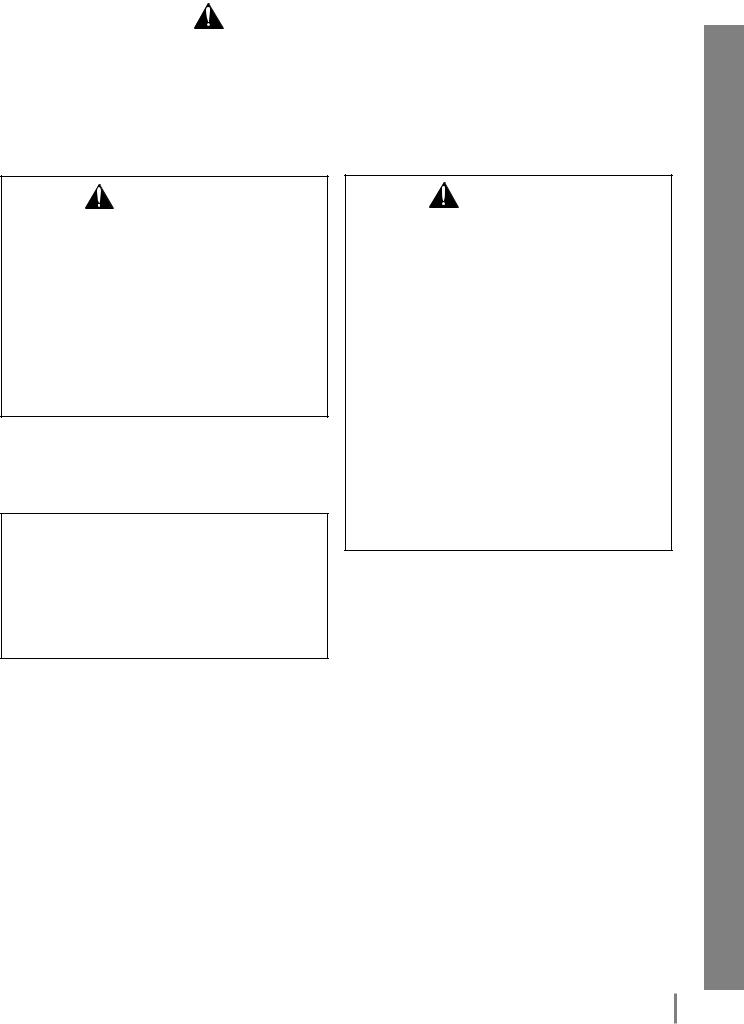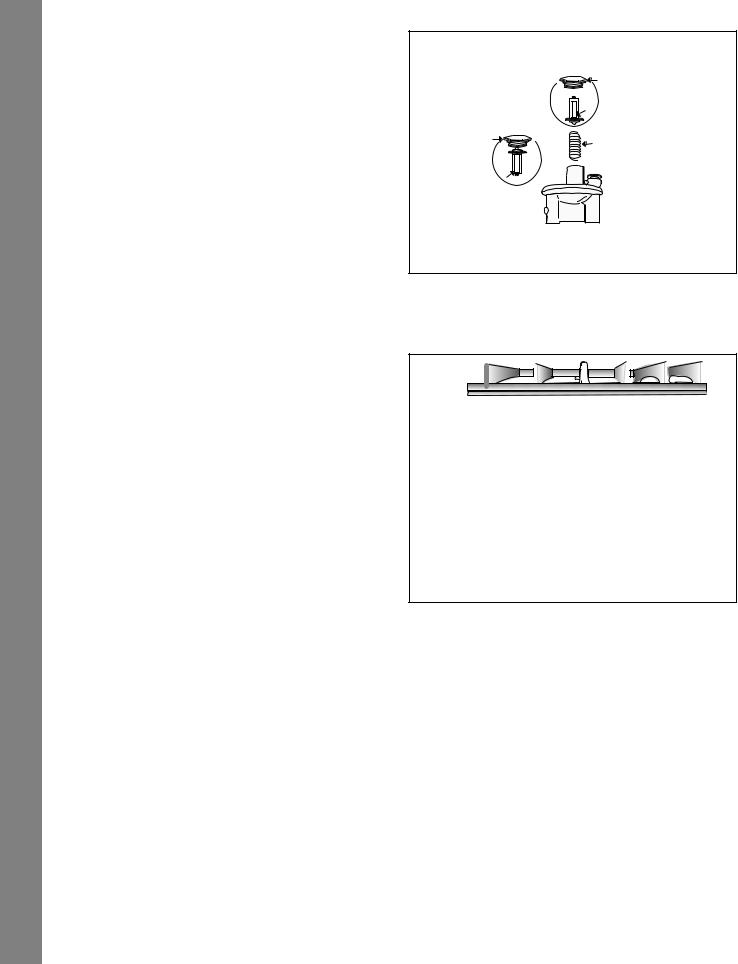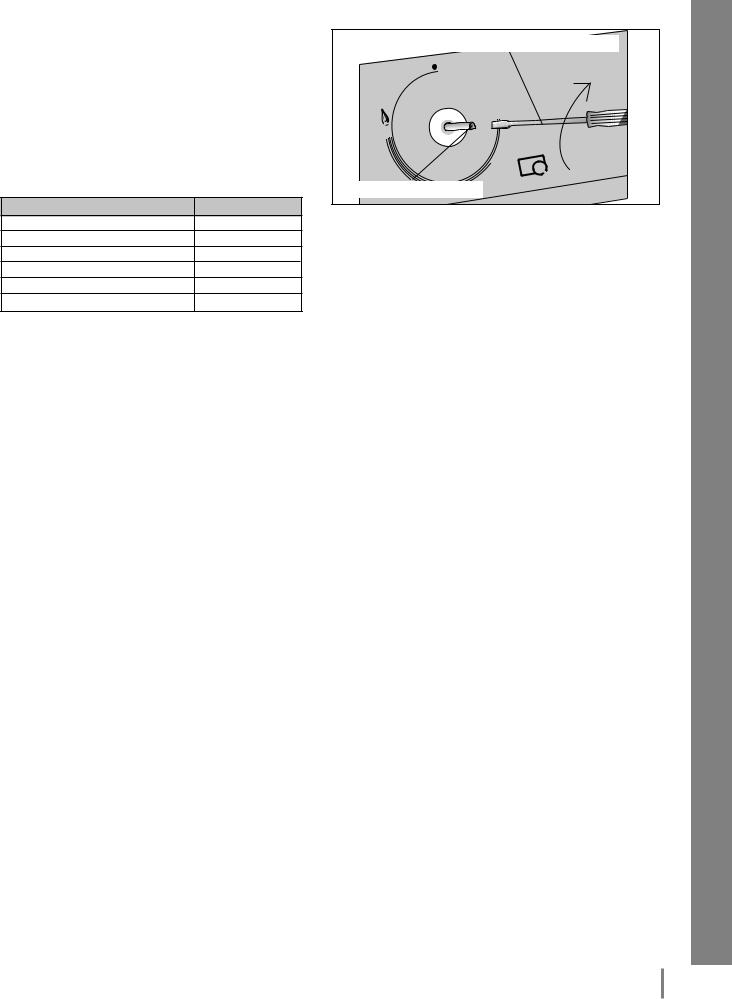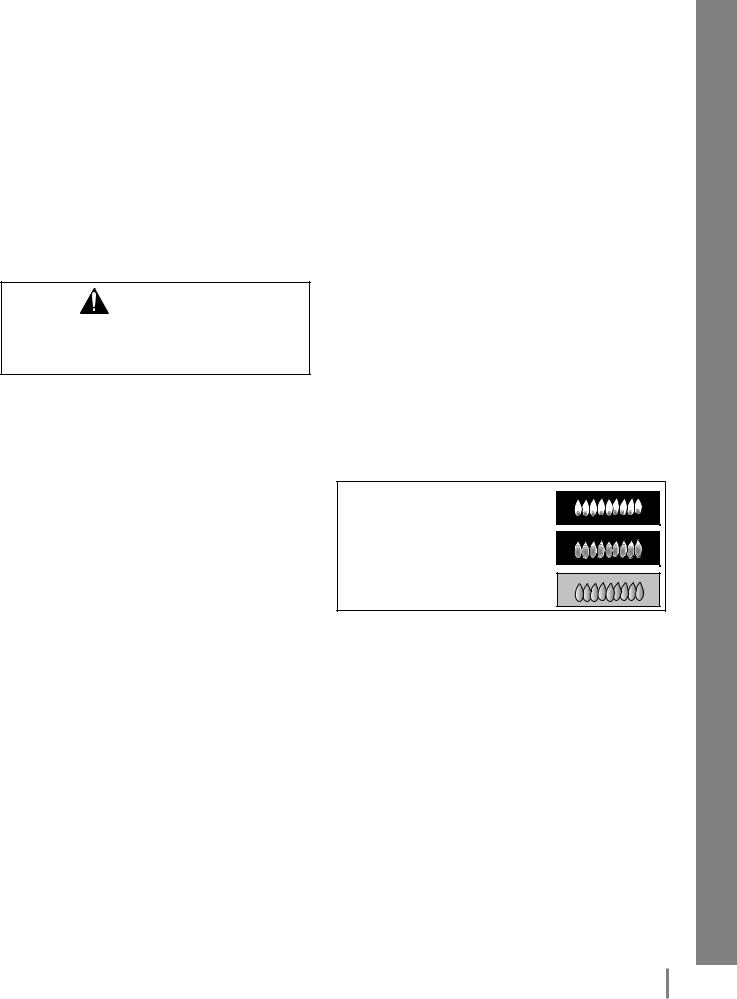Siemens hg2415uc, hg2416uc, hg2515uc, hg2516uc, hd2515u Conversion kit
...
s
xTronic™ Gas Convection Range
LP Conversion Kit
Cuisinière à gaz Nécessaire de conversion LP Estufa de Gas Kit de Conversión a Gas LP
For use with models: HG2415UC, HG2416UC, HG2515UC,
HG2516UC, HD2515U, HD2516U, HD2515C, HD2416C
Please read instructions before using.
Important: Save these instructions.
Installer: Please leave these instructions with this unit for the owner.
Owner: Please retain these instructions for future reference.

FR
Emplacementorifice surface de cuisson LP
|
DOS CUISINIÈRE |
ArG |
ArD |
AvG |
AvD |
|
DEVANT CUISINIÈRE |
Arrière gauche (ArG) Brûleur - 101 (Rouge) Avant gauche (AvG) Brûleur - 86 (Jaune) Arrière droit (ArD) Brûleur - 70 (Vert)
Avant droit (AvD) Brûleur - 116 (Blanc)
EN
LPCooktopOrificePlacement
BACK OF RANGE
LR |
RR |
LF |
RF |
FRONT OF RANGE
Left Rear (LR) Burner - 101 (Red)
Left Front (LF) Burner - 86 (Yellow)
Right Rear (RR) Burner - 70 (Green)
Right Front (RF) Burner -116 (White)
ES
Colocación de Orificios de Estufa LP
|
FONDO DE ESTUFA |
TI |
TD |
DI |
DD |
|
FRENTE DE ESTUFA |
Tras Izq. (TI) Quemador - 101 (Rojo)
Delant Izq. (DI) Quemador - 86 (Amarillo)
Tras Der. (TD) Quemador - 70 (Verde)
Delant Der. (DD) Quemador - 116 (Blanco)

Important Safety Instructions
Please read Installation Instructions before beginning the conversion.
This kit is used to convert dual fuel ranges and gas ranges from natural gas operation to propane (LP) gas operation. Only HD and HG model Siemens ranges can be converted using this kit*.
Please read all instructions before proceeding. Save the natural gas parts for possible conversion from LP back to natural gas in the future.
WARNING
This conversion kit shall be installed by a qualified service agency in accordance with the manufacturer’s instructions and all applicable codes and requirements of the authority having jurisdiction. If the information in these instructions is not followed exactly, a fire, explosion or production of carbon monoxide may result causing property damage, personal injury or loss of life. The qualified service agency is responsible for the proper installation of this kit. The installation is not proper and complete until the operation of the converted appliance is checked as specified in the manufacturer’s instructions supplied with the kit.
High Altitude Installation Note:
This range is CSA certified for safe operation up to an altitude of 10,000 ft. without any modifications (except LP conversion, when applicable).
For Massachusetts Installations:
1.Installation must be performed by a qualified or licensed contractor, plumber or gas fitter qualified or licensed by the state, province or region where this appliance is being installed.
2.Shut-off valve must be a “T” handle gas cock.
3.Flexible gas connector must not be longer than 36 inches.
Kit Contents:
Conversion Kit Instructions
Conversion Sticker
4 LP Orifices (70, 86, 101, 116)
Tools Required:
7 mm Socket Driver w/ 3” extension Torx (T20)-head screwdriver Adjustable Wrench
Flathead Screwdriver (1/8” or smaller) Phillips Head Screwdriver
CAUTION:
(1)When connecting the unit to the propane gas, make certain the propane gas tank is equipped with its own high pressure regulator. In addition, a pressure regulator was supplied with the range. This second regulator must be installed with the range.
The maximum gas pressure to this appliance is not to exceed 14.0 inches water column from the propane gas tank regulator.
The following must be met when testing supply piping system:
a)The appliance and its individual shut-off valve must be disconnected from the gas supply piping system at test pressures in excess of 1/2 psig (3.5 kPa).
b)The appliance must be isolated from the gas supplypipingsystembyclosingitsindividual manual shut-off valve during any pressure testing of the gas supply piping system at test pressures equal to or less than 1/2 psig (3.5 kPa).
Always Provide Adequate Gas Supply
Siemens Freestanding Dual Fuel and Gas Ranges are shipped from the factory for use with natural gas. Use this kit to convert the appliance for LP gas use if necessary. Observethefollowing:
•Be sure the range is converted for use with the appropriate gas before using it.
•Your range is designed to operate at a pressure of 10” of water column when used with LP gas.
•When checking for proper operation of the regulator, the inlet pressure must be at least 1” greater than the operating (manifold) pressure above. When converting for LP gas use, the pressure supplied to the regulator must be between 11” and 14” of water column. See step 2 “Convert Pressure Regulator from 5” to 10” W.C.”, next page.
•The pressure regulator located in the inlet of the range manifold must remain in the supply line.
•Use a flexible metal appliance connector or rigid pipe to connect the Range to the gas supply. The connector should have an I.D. of 1/2” and be 5’ in length (Exception: Maximum connector length in Massachusetts installations is 3’). In Canada, the connector must be single wall metal and not longer than 6’.
*The model number is stamped on the plate behind the warming or storage drawer. |
English • 1 |
Safety
Begin You Before
Cooktop/Oven
Conversion Test

Safety
Before You Begin
Cooktop/Oven
Test Conversion
Conversion Instructions - Before you begin
1. CAUTION: Turn off Gas and Electricity
CAUTION: Turn off Gas and Electricity
Before proceeding with the conversion; shut off the gas supply to the appliance prior to disconnecting the electrical power.
Shut off the outside propane tank gas valve to the range. Remove range power cord from electrical outlet or turn breaker off at breaker box, and turn all control knobs to the “OFF” position.
2. Convert Pressure Regulator from 5” W.C. to 10” W.C.
1.Remove Warming Drawer; Pull drawer out until stop is reached. Facing the range, push clip on left side up and clip on right side down. Pull drawer the rest of the way out.
2.Remove cover plate from interior back wall by removing single screw on left side of panel. Use a torx T-20 head screwdriver.
3.Remove the hexagon cap from the top of the regulator with an adjustable wrench.
4.Pop out the plastic stem in the cap and turn it over pressing it firmly in place so that the letters “LP” (rather than “NAT”) are seen upright in the stem .
5.Replace the cap and button assembly into the top of the regulator sealing it firmly. Make certain spring is still in place (See Fig. 1). DO NOT OVER TIGHTEN.
6.Fill out and affix the CONVERSION STICKER on the back side of the cover plate so that it appears on the back side of range next to the regulator.
3. Replace Main Cooktop Orifices
Remove Grates, Burner Caps and Burner Bases. Unscrew two (2) T20 screws inside each base and remove burner bases (See Figure 2). Reinsert screws in jet holder to hold tubing assembly in place.
Remove Natural Gas Cooktop Orifices. Insert the socket driver with 3” minimum extension into the jet holders to remove existing orifices. Place the old orifices in the space provided on page 6 in case future conversion back to natural gas is necessary.
Assemble LP Cooktop Orifices. Place in cooktop exactly as laid out on the inside of the front cover of this manual (also shown in Figure 3). If the orifices become separated from the cover, placement can be determined by matching the number and/or color on the orifice with the placement specifications displayed in Figure 3. Place the new orifice into the socket then insert each orifice into its respective threaded hole in the jet holder. Tighten until the orifice stops turning. DO NOT OVER TIGHTEN.
Remove screws to replace burner base, burner cap and burner grate. Replace screws.
Note: Burner cap must be properly positioned on burner base for burner to light.
|
|
Pin |
Position |
|
|
for Propane |
|
|
|
|
Hex |
|
|
|
Cap |
Pin Position |
LP |
||
for Natural Gas |
LP |
||
|
|||
Hex |
|
|
Spring |
Cap |
|
|
|
|
|
|
|
|
NA |
Pin |
|
NAT |
T |
|
|
|
|
|
|
PRESSURE REGULATOR VIEW
Figure 1 - Convert Pressure Regulator
Grate |
Burner Cap |
Burner Base |
Orifice |
Ignitor |
Figure 2 - Remove Grate, Cap and Base
Left Rear Burner - |
Right Rear Burner - |
|
11,000 BTU/h 101 (Red) |
5,000 BTU/h 70 |
|
|
BACK OF RANGE |
(Green) |
|
|
|
|
|
|
FRONT |
OF RANGE |
Left Front Burner - |
Right Front Burner - |
7,500 BTU/h 86 |
15,000 BTU/h 116 |
(Yellow) |
(White) |
Figure 3 - LP Cooktop Orifice Placement

|
|
Conversion Instructions - Cooktop |
|
|
4. Convert Cooktop Valves for Propane Use |
1/8” (or Smaller) Flathead Screwdriver |
Safety |
||
|
out on the bezel. |
|
||
|
|
SIM |
||
Adjust Bypass Jets on Valves |
|
|
|
|
1. |
Verify that all knobs are in the “Off” position. |
OFF |
|
|
2. |
Remove knobs, springs and bezels by pulling straight |
|
|
|
3. |
Insert 1/8” (or smaller) flat head screwdriver into |
|
|
|
|
shaft and turn bypass screw clockwise until it stops |
HI |
|
|
|
|
|
|
|
|
turning (bypass screw is inside shaft). See Figure 4. |
|
|
|
|
DO NOT OVER TIGHTEN. Replace springs, bezels and |
LO |
|
|
|
|
|
|
|
|
knobs. |
|
Bypass Screw Inside Shaft |
|
|
|
|
Before |
|
|
Burner |
BTU/h - LP Gas |
Figure 4 - Cooktop Valve |
|
|
Cooktop - Left Rear |
11,000 |
|
|
|
Cooktop - Right Rear |
5,000 |
|
|
|
Cooktop - Left Front |
7,500 |
|
|
|
Cooktop - Right Front |
15,000 |
|
You |
|
Oven - Broil (Gas Ranges Only) |
13,500 |
|
|
|
|
|
||
|
Oven - Bake (Gas Ranges Only) |
17,000 |
|
Begin |
If your range is dual fuel your conversion is complete. |
|
|||
|
|
|||
Replace the cover plate and warming drawer and |
|
|
||
proceed to step 9 to test your conversion. |
|
|
||
For gas range conversions, continue to step 5, next page.
Cooktop/Oven
Conversion Test
English • 3

Safety
Before You Begin
Cooktop/Oven
Test Conversion
Conversion Instructions - Oven (Gas Ranges Only)
5. Adjust Broil Burner Orifice |
6. Adjust Bake Burner Orifice |
Broil Orifice Conversion
Tightened, but not fully seated
Natural Gas Setting |
LP Gas Setting |
Bake Orifice Conversion
Fully seated
Natural Gas Setting |
LP Gas Setting |
CAUTION!
DO NOT overtighten the broil burner orifice. Overtightening may result in damage to the pin inside the orifice. This affects cooking performance. It could cause inconsistent flames and unintentional release of carbon monoxide.
Remove oven door (see section “Removing Oven Door” in Use and Care manual).
Remove Broil Burner Assembly. The broil burner assembly is attached to the top of the oven cavity with 7 screws. Remove screws and gently pull broil burner assembly straight out being careful not to detach electrical wires. Place broil burner against back wall of oven cavity.
Adjust Broil Orifice. The orifice is located behind the broil burner in the back oven wall (See Figure 5). Use a 1/ 2” deep socket driver with 3” minimum extension to turn orifice clockwise until it stops (2- 2 1/2 turns). DO NOT OVERTIGHTEN.
Replace Broil Assembly. Replace broil assembly being careful to feed all wires through back wall of oven. Reinsert all 7 screws.
Note: The air shutter on the broil burner fits over the orifice when installed correctly.
Tighten Bake Orifice. The bake burner orifice is located below the air shutter (See Figure 6). Reach it through the access hole in the interior back panel of the warming drawer cavity. Use a 1/2” wrench to turn orifice clockwise until it stops (2 1/2 - 3 turns). Unlike the broil burner orifice, the bake burner orifice should be tightened as far as it will go in order to ensure that complete conversion has occurred.
Broil Orifice
Figure 5 - Broil Orifice: Oven Cavity Side View
Bake Orifice |
Shutter |
Figure 6 - Bake Orifice and Air Shutter

Conversion Instructions - Test the Conversion
7. Test for Gas Leaks
Leak testing is to be conducted by the installer according to the instructions given in this section.
Turn on supply line gas shut off valve. Apply a noncorrosive leak detection fluid to all joints and fittings in the gas connection between the supply line shut-off valve and the range. Include gas fittings and joints in the range if connections may have been disturbed during installation. Bubbles appearing around fittings and connections indicate a leak.
If a leak appears, turn off supply line gas shut-off valve and tighten connections. Retest for leaks by turning on the supply line gas shut-off valve. When no bubbles appear, test is complete. Wipe off all detection fluid residue.
CAUTION
NEVER CHECK FOR LEAKS WITH A FLAME. DO NOT CONTINUE TO THE NEXT STEP UNTIL ALL LEAKS ARE ELIMINATED.
8. Test Electric Ignition
Test Cooktop Burner Ignition. Select a rangetop burner knob. Push down and turn to the flame symbol. If the ignitor/spark module is operating correctly, it will click. Once the air has been purged from the supply lines, the burner should light within four (4) seconds. After burner lights, turn knob to the off position.
Test each rangetop burner in this fashion.
Test Broil Burner Ignition. Set cooking mode to Hi Broil. The burner will ignite after 30-75 seconds.
Test Bake Burner Ignition. Set the oven to bake at 350° F. After 30-75 seconds, the burner will ignite. The burner will stay lit until the 350° F is reached and then shut off.
From this point forward, the burner will cycle on and off to maintain the temperature.
CallSiemensService866-44SIEMENS(447-4363)if:
1.Any of the burners do not light.
2.The broil burner or bake burner does not stay lit.
3.The bake burner does not cycle.
9. Test Flame
The combustion quality of the flame for each burner must be visually inspected. If your range is a gas range, the bake burner and broil burner flames must also be visually inspected. The flame should be blue with yellow tips. It should carry over, or surround, the entire burner and should not lift or blow off the burner.
To inspect, turn the burner on. See Figure 7 for appropriate flame characteristics. To view the bake burner, the oven bottom cover must be removed; remove two rear thumb screws, slide forward and out.
If the flame is completely or mostly yellow, the corresponding air shutter and/or the orifice must be adjusted. Verify that the orifice is all the way tightened. If the flame is still yellow, adjust the air shutter. After adjustment,retest.
Note: With LP use, some yellow tipping on outer cones is normal.
All burners must also be inspected for carryover. The flame should completely surround the burner. If the cooktop burners do not carry over, the bypass jet must be adjusted (See step 4, page 3). If the broil or bake burner does not carry over, adjust the corresponding air shutter (see steps 10 and 11, below and next page).
Yellow Flames:
Further adjustment is required.
Yellow Tips on Outer Cones:
Normal for LP Gas.
Soft Blue Flames:
Normal for Natural Gas.
Figure 7 - Flame Characteristics
Safety
Begin You Before
Cooktop/Oven
Conversion Test
English • 5
